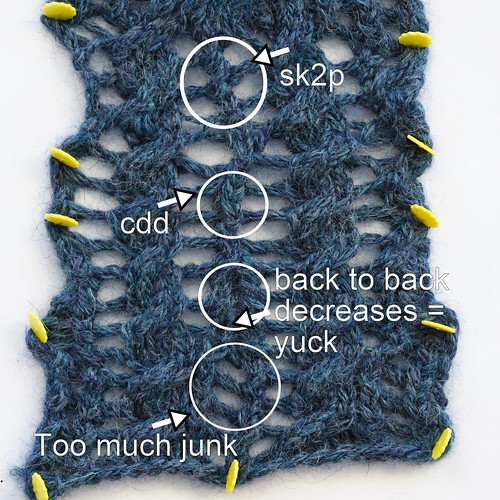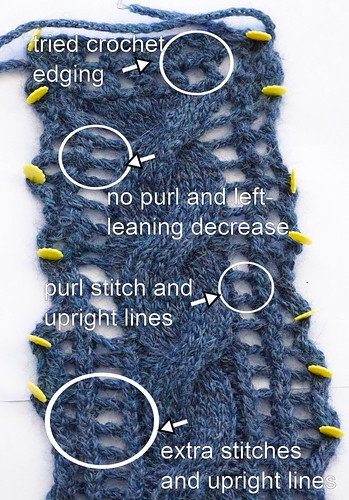Merlon Cowl Revisited
Today I'm going to go through a bit of my design process for the Merlon Cowl.

This design started when I opened up a bag of Rowan Lima at the shop. It's one of those yarns that you can't put down. It is soooo soft and buttery. I bought 2 balls with the vague plan to make some sort of cowl. Something that soft *needs* to be worn around the neck.
A huge shortcut in the stitch pattern choosing phase fell into my lap with the arrival of Rowan's Lima Collection book. True to Rowan style, it featured many heavily cabled sweaters. The loveliness of the cabled fabric came as a surprise to me. Lima has an icord-like construction instead of a traditional ply. The yarn is very round, which is very desirable for cables, but I thought the construction would detract from that kind of stitch pattern. As you can see from the designs in the book, that is not the case.
From that point, I had a few stitch patterns from a Japanese stitch dictionary that had caught my eye. I thought it was a good idea to combine cables and mesh because alpaca can be very warm.

The first stitch pattern I tried was too cluttered, with too many stitches in the mesh pattern.
There wasn't enough contrast between the cable and the mesh. I made sure each cable had a yo on either side and tried back to back decreases. It was still cluttered, so I cleaned up the mess with a centered double decrease. I wasn't thrilled with the look of that, so I switched to a sk2p double decrease. I was then forced to admit that the small cables weren't really a match for the fuzziness of the yarn.

I started with another pattern from the dictionary. I obviously hadn't learned from my mistakes because this one also had multiple stitches between the cables and eyelets. First I got rid of the intervening knit stitch on either side of the columns of cables, then the inside purl stitch. These patterns also used a centered decrease. I changed that to a left-slanting double decrease and I liked the results.
My first try for the edging was double crochet, because it has a very similar look to a left slanting double decrease. The crochet had a tendency to bias, so I came up with a simple eyelet edging that could be knit in the same piece as the main body. I'd seen some similar edgings used effectively on other cowls. Although the eyelets in the edging aren't that open and don't match the decreases in the main body, the final choice makes the piece easier to work and doesn't require crochet knowledge.

This design started when I opened up a bag of Rowan Lima at the shop. It's one of those yarns that you can't put down. It is soooo soft and buttery. I bought 2 balls with the vague plan to make some sort of cowl. Something that soft *needs* to be worn around the neck.
A huge shortcut in the stitch pattern choosing phase fell into my lap with the arrival of Rowan's Lima Collection book. True to Rowan style, it featured many heavily cabled sweaters. The loveliness of the cabled fabric came as a surprise to me. Lima has an icord-like construction instead of a traditional ply. The yarn is very round, which is very desirable for cables, but I thought the construction would detract from that kind of stitch pattern. As you can see from the designs in the book, that is not the case.
From that point, I had a few stitch patterns from a Japanese stitch dictionary that had caught my eye. I thought it was a good idea to combine cables and mesh because alpaca can be very warm.

The first stitch pattern I tried was too cluttered, with too many stitches in the mesh pattern.
There wasn't enough contrast between the cable and the mesh. I made sure each cable had a yo on either side and tried back to back decreases. It was still cluttered, so I cleaned up the mess with a centered double decrease. I wasn't thrilled with the look of that, so I switched to a sk2p double decrease. I was then forced to admit that the small cables weren't really a match for the fuzziness of the yarn.

I started with another pattern from the dictionary. I obviously hadn't learned from my mistakes because this one also had multiple stitches between the cables and eyelets. First I got rid of the intervening knit stitch on either side of the columns of cables, then the inside purl stitch. These patterns also used a centered decrease. I changed that to a left-slanting double decrease and I liked the results.
My first try for the edging was double crochet, because it has a very similar look to a left slanting double decrease. The crochet had a tendency to bias, so I came up with a simple eyelet edging that could be knit in the same piece as the main body. I'd seen some similar edgings used effectively on other cowls. Although the eyelets in the edging aren't that open and don't match the decreases in the main body, the final choice makes the piece easier to work and doesn't require crochet knowledge.



Comments